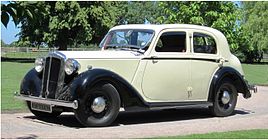- Daimler New Fifteen
-
Daimler 15 
Manufacturer The Daimler Motor Company Limited Also called Daimler New Fifteen Production 1937 - 1940. Approx 2850 made[1]. Successor Daimler DB18 Body style four door “six light” saloon
four door “four light sports saloon”
others as arranged with coachbuilder by customer [2]Engine 2,166 cc 6-cylinder in-line ohv (at launch)
2,522 cc 6-cylinder in-line ohv (later)[2]Transmission 4-speed manual Fluid Flywheel Transmission with preselective self-changing gearbox[3] Wheelbase 114 in (2,900 mm)[2] Length 180 in (4,600 mm)[2] Width 65 in (1,700 mm)[2] The Daimler New Fifteen, also called the DB17 was a large saloon/sedan car at the lower end of the manufacturer’s range, introduced towards the end of 1937 and offered for sale by Daimler in 1938 and 1939. During this time it acquired a larger engine, and by 1939 it had been developed into the Daimler DB18, its successor.
Contents
Launch
1937 saw the opening, in September, of what was intended to be the world’s largest exhibition hall at Earls Court on the western edge of central London. The inaugural exhibition involved chocolate and confectionery: six weeks later the Motor Show opened on 14 October. For Daimler, the star of the first “Earls Court Motor Show” was the new Daimler Fifteen, described in their advertisements as “the most interesting car of the year”. [3]
Engine and running gear
The car featured a 2,166cc ohv straight-six engine for which a maximum power output of 56 bhp at 3,600 rpm was claimed. By the time the car was replaced the engine had grown to a displacement of 2,522cc with 66 bhp,[4] and in this form would power Daimler civilian and military vehicles until well into the 1950s.
Although the word "Fifteen" in the model's name was notionally a reference to its fiscal horse-power, strict application of the RAC formula used to compute fiscal horsepower gives a higher fiscal horse power category of 17hp even for the smaller engine with which the car was launched: by this time, like other mainstream UK manufacturers, Daimler were using a notional fiscal horse-power rating to define the class in which the car competed rather than to identify its actual tax classification.
Power was delivered to the rear wheels via a Fluid flywheel transmission system that the company had introduced in larger cars at the beginning of the decade and which was by now a feature that extended across the range.
The chassis was essentially the same as that used on the previous "15" model but with wider track[1]. The final drive used a worm reduction gear. An innovative feature of the New Fifteen was the fitting of “independent front wheels springing” [3] in the form of coil springs at the front. The manufacturer’s advertising made much of the secure roadholding that resulted.
The body
The standard body was a spacious “six light” saloon, following the pattern adopted by many British middle-weight cars of the period, but a more stylish four door sports saloon, 4 door cabriolet, fixed head coupé (1937 only) and two door drophead coupé were also available[1] and buyers prepared to pay for a body from a specialist body builder would have faced a reassuringly wide range of possibilities including a smart "razor edge" style.
References
- ^ a b c Sedgwick, M. (1989). A-Z of Cars of the 1930s. Devon, UK: Bay View Books. ISBN 1-870979-38-9.
- ^ a b c d e Culshaw; Horrobin (1974). Complete Catalogue of British Cars. London: Macmillan. pp. 115. ISBN 0-333-16689-2.
- ^ a b c "Daimler Advertisement in Autocar Magazine". Autocar (68): 768–769. November 1937.
- ^ Display advertisement Punch October 26, 1938
External links
Categories:- Daimler vehicles
- Vehicles introduced in 1937
Wikimedia Foundation. 2010.
